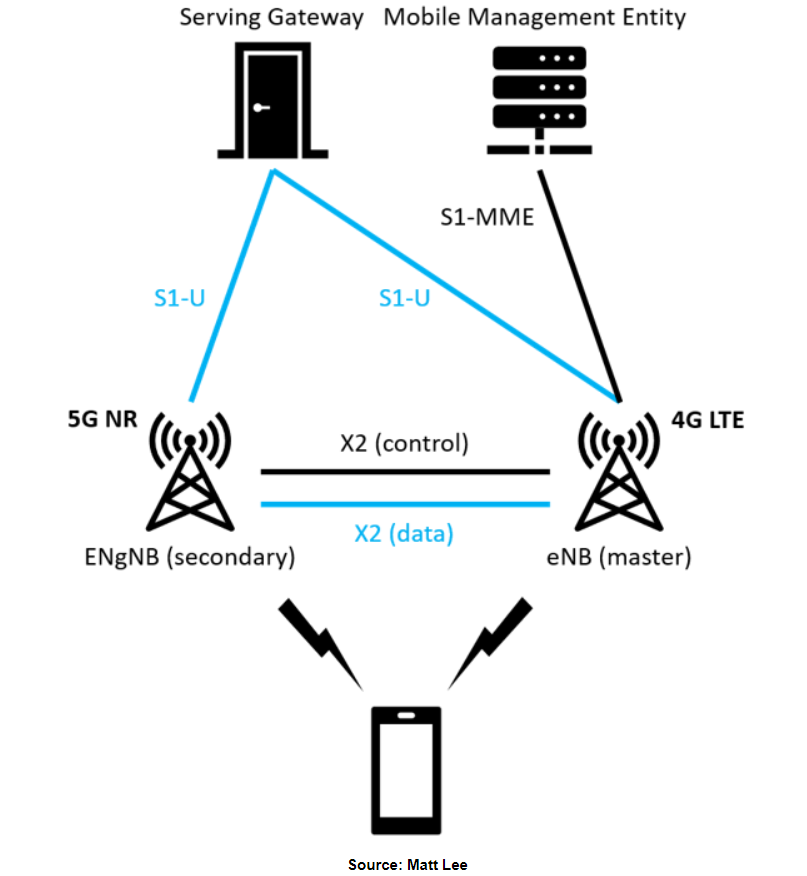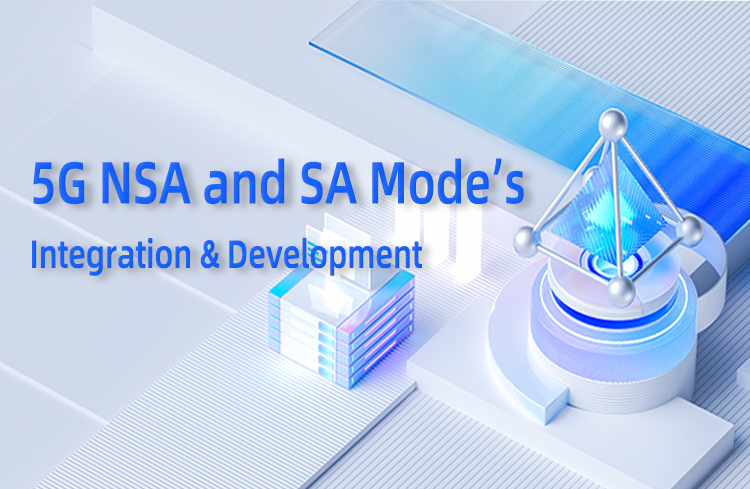Signaling in the two network modes
Standalone (SA) and non-standalone (NSA) are two configuration modes of 5G New Radio (NR) in the actual network development process. NSA, as a networking solution that can quickly provide 5G capability and achieve large-scale deployment, has attracted great attention in the industry. In general, NSA is achieved through multi-RF technology, the Multi-RAT Dual Connectivity (MR-DC). Although the NSA mode also has a variety of implementation forms, such as Evolved-Universal Terrestrial Radio Access (E-UTRA) NR Dual Connectivity (EN-DC), Next-Generation Radio Access Network (NG-RAN) E-UTRA Dual Connectivity (NGEN-DC), NR — E-UTRA Dual Connectivity (NE-DC) and New Radio Dual Connectivity (NR-DC), it is generally considered that the core network is based on the 4G core network Evolved Packet Core (EPC), which anchors the 4G base station Evolved Node B (eNB) as the primary node and the NR base station gNodeB (gNB) as the secondary node. This form is the cognitive category of the current NSA mode, that is EN-DC.

SA independent networking mode is completely away from the anchor of 4G at the base station side, and the core network is completely transformed from EPC to 5G Core (5GC). In addition to the differences in network physical architecture, from the perspective of system process design, a significant difference between NSA mode and SA mode lies in the routing of high-level signaling processes. The signaling process path of SA is going through 5GC gNB user equipment (UE), that is, 5G core network using 5G NR base station to handle the signaling interaction with UE, while the signaling flow path of NSA is (taking EN-DC as an example) that 4G core network uses 4G base station as the main node to handle signaling interaction. At the same time the 5G base station can also choose the form of auxiliary node for signaling transmission, but there is no signaling interworking between EPC and 5G base station. Signaling interworking can be done between 5G base station secondary node and 4G base station primary node through the X2 interface.
The three channels of control plane
The wireless communication system is mainly used to solve the problem of information exchange through radio waves, and the control signaling transmission needs to be done before the service data transmission. According to the division of wireless communication protocol stack, each layer contains control plane signaling, such as radio resource control (RRC) signaling of the RRC layer, control unit of Medium Access Control (MAC) layer or ACK/NACK message of physical layer, and in the communication node (base station/terminal), the channels that transmit these control plane signals from upper layer to lower layer are logical channel, transmission channel and physical channel, and certainly, these channels can also transmit user information. In the design of mobile communication systems before 4G, these three kinds of channels from high to low are basically undertaking mapping relationships. In the design of 4G systems, physical uplink control channel (PUCCH), physical downlink control channel (PDCCH), physical hybrid-automatic-repeat-request indicator channel (PHICH) and physical control format indicator channel (PCFICH) are innovatively introduced into the uplink and downlink physical channels, which have no undertaking relationship with the high-level protocol stack and only deal with the physical layer process.
The advantage of designing some physical channel functions independently from the vertical protocol stack is that it can improve the timeliness of control plane signaling interaction and achieve dynamic resource management. In contrast, the network and terminal exclusive signaling interaction through RRC or MAC layer control message can be considered as a semi-static signaling transmission or resource management mode. The configuration of parameters and resources by decoding cell level system messages can be considered as static resource management mode.
We try to analyze the characteristics of the networking mode of NSA and SA in 5G from the perspective of this timeliness resource allocation mode. An essential difference between them is the signaling path ownership of static/semi-static resource allocation in 5G cells. Compared with the single vertical path of signaling in SA mode, the high-level signaling messages in NSA mode are encapsulated into some byte sequences, which are delivered through the RRC messages of the primary node (eNB). In order to improve the reliability of signaling message delivery, NSA (EN-DC) mode also supports 4G signaling messages signaling radio bearer (SRB1/SRB2) to be delivered to the terminal by dual routing of the primary and secondary nodes. Some fast resource configuration of secondary nodes in NSA connection mode (with EN-DC configuration) is achieved, such as mobility measurement and reporting configuration between secondary nodes (gNB). The network side can also enable SRB3 exclusive configuration for this purpose. At this time, the primary node does not need to coordinate intervention, and the fast-signaling interaction between secondary nodes and terminals can be accomplished in special application scenarios.
Concerns with NSA
At present, disputes about the development of NSA and SA in the industry mainly focus on whether NSA can meet the ultra-low latency requirements of the future internet of vehicles, and whether it can support network slicing based on different services. For the latency concern, it mainly involves two parts: access latency and scheduling latency. When the terminal accesses the network in NSA network, because the primary and secondary nodes need to carry out signaling interaction in advance, the access delay is limited to a certain extent compared with SA network. When the terminal enters the connected state, the adjustment delay mainly depends on the system's ability to process information interaction and the corresponding wireless frame structure. Although the millimeter level scheduling capability of 4G devices in the current network is generally inferior to 5G, with the forward design and improvement of 3GPP for the standard before 4G, the scheduling concept based on time slot or sub time slot is proposed, which means that the future development of 4G system is also evolving toward high reliability and low delay. From this point of view, the goal of NSA and SA in scheduling delay optimization is convergence with the maturity and stability of network structure and coverage, access delay can be optimized to a certain extent.
Another concern is whether NSA can provide network slicing capability. Since the service-based network slicing scheduling capability is mainly achieved in the core network, the essential solution to this problem does not lie in the change of wireless networking mode but lies in the transformation and upgrading of the existing 4G core network EPC to the 5GC core network based on service. If the core network adopts 5GC, the core network will be upgraded. The wireless network architecture adopts the non-independent networking architecture of NGEN-DC, and the service-based network slicing ability can also be done.
Although we can recognize the characteristics of NSA networking and SA networking from another dimension, we still need to be aware of some problems that need to be solved in the current large-scale implementation of NSA networking. As NSA needs to provide services through 4G anchor, the collaborative optimization of anchor frequency and NR secondary node frequency needs further attention. In addition, due to the numerous anchor points, it is easy to lead to wireless signal clutter, and 5G signal may be displayed on the terminal. However, due to the limited frequency coverage of NR secondary nodes, the user perception is reduced.
Conclusion
In any case, only a more comprehensive and more dimensional understanding of the characteristics of NSA and SA networking mode will enable selection of technical solutions according to 5G business requirements. In essence, there are not too many advantages and disadvantages in technology. The key lies in whether it meets the application needs.
Source: https://electronics360.globalspec.com/article/19264/the-integration-and-development-of-5g-nsa-and-sa-mode


